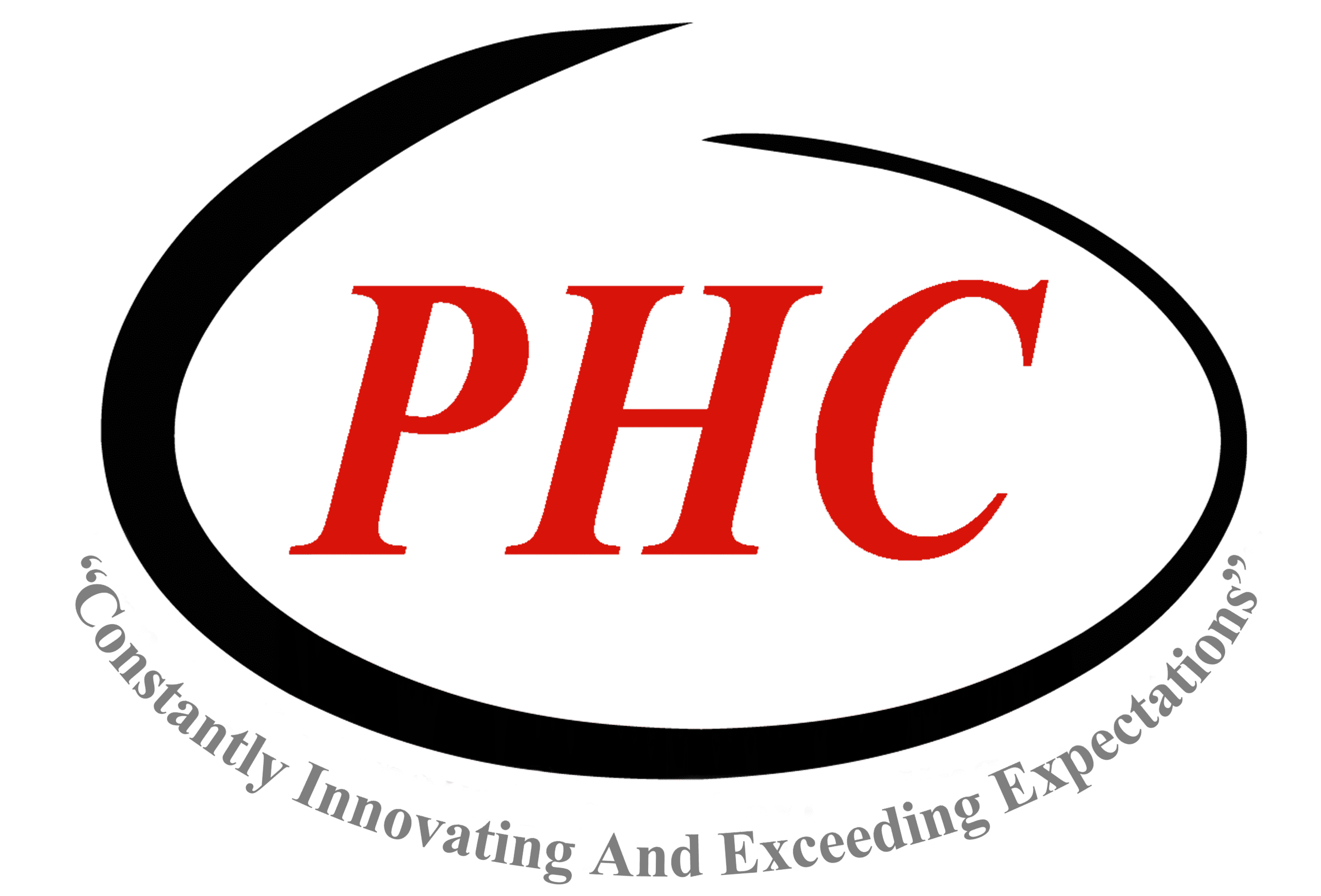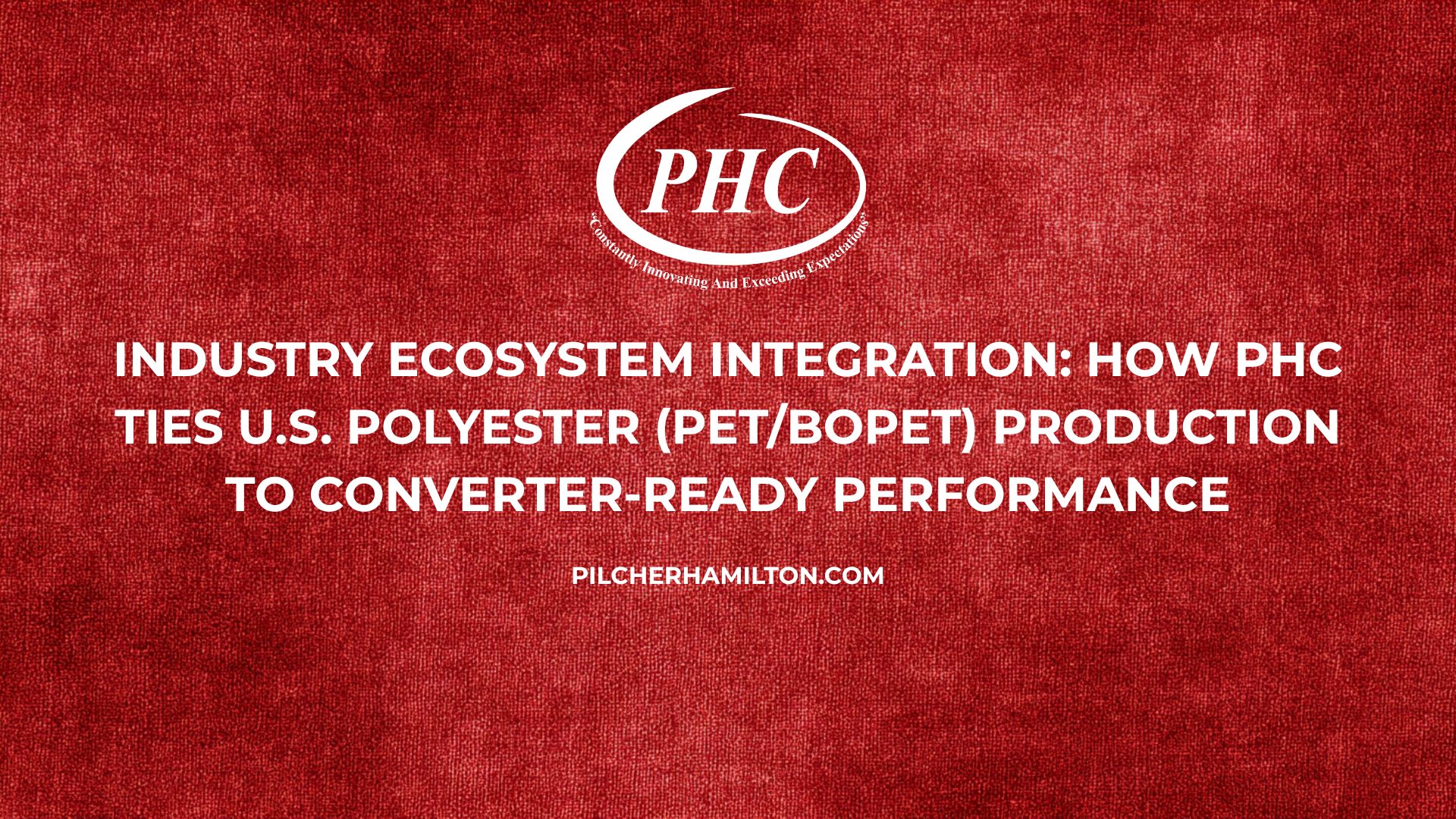Polyester Film Supply Chain. Quick context for engineers & buyers. Pilcher Hamilton Corporation (PHC) is a merchant supplier and converter—we do not make base PET/BOPET. We source domestic films and add value at our Greer, South Carolina hub with slitting, roll‑to‑roll coating (PVDC, silicone, acrylic, anti‑fog/anti‑static), corona treatment, sheeting, winding, printing, and toll converting. Typical envelopes we support and keep in stock: 8–200 µm gauges (≈0.32–7.87 mil), 38–52 dyn/cm surface energy, 0.2–0.6 COF, 200–400 °F seal windows, and barrier options down to OTR <1 cc/m²/day (metallized PET) and OTR 5–10 cc/m²/day (transparent PVDC‑PET). Learn more: All Services, All Products.
1) The U.S. PET/BOPET “ecosystem”—and which plants do what
To integrate effectively, it’s vital to be precise about who actually makes PET film in which state:
- South Carolina — Mitsubishi Polyester Film (Greer). MPF operates one of the largest U.S. PET film sites in Greer, SC (corporate contact and facility pages list Greer as the U.S. polyester film division headquarters). For decades, this has been an anchor for domestic BOPET supply—and it sits minutes from PHC’s converting hub.
- Virginia — DuPont Teijin Films (Chester/Hopewell/Richmond “Spruance”). DTF’s U.S. regional HQ and PET manufacturing (Mylar®, Melinex®) are documented at the Chester/Hopewell addresses; current ISO certificates explicitly cover “development, manufacture and supply” of PET films in Virginia.
- Alabama — Polyplex USA (Decatur). Polyplex has expanded U.S. BOPET capacity with a second PET film line and a dedicated coating line in Decatur, AL, entering service 2024–2025—useful for barrier and specialty grades.
- Rhode Island — Toray Plastics (America), North Kingstown. Toray’s Lumirror® division manufactures PET film in RI; corporate pages list the site and the Lumirror product family (including metallized options).
- Kentucky — Flex Films (UFlex), Elizabethtown. Flex Films operates a PET film plant (FLEXPET™) and converting assets in KY.
- New York — Terphane (Bloomfield). Note the Bloomfield, NY plant closure announced April 2025; check current availability before assuming supply from this site.
Two important clarifications (to avoid spec errors):
- Ohio (Circleville) is DuPont Kapton® polyimide, not PET. Circleville expansions and press releases are explicit: Kapton® and Pyralux®—not BOPET. If your internal spec says “DuPont OH PET,” that’s a mismatch.
- Jindal in the U.S. is BOPP/BOPE—not PET—with U.S. operations centered on Shawnee, OK (and regional functions in GA). If your bill of materials lists “Jindal PET (PA),” that’s almost certainly a data hygiene issue.
2) Where PHC plugs in
We bridge the producers above with converter‑ready output—from the Greer, SC hub that co‑locates stock, coating, slitting, QC, and fulfillment:
- Slitting & winding: 1–60 in finished widths; ±0.005 in tolerance; 3″/6″ cores; splice rules and defect maps to your SOP. Slitting, Winding.
- Sheeting: up to 60″ × 100″, ±0.010 in. Sheeting.
- Corona treatment: side‑specific to 38–52 dyn/cm for ink/adhesive anchorage. Corona‑treated.
- Coating: 0.5–5 µm add‑on typical (PVDC for O₂/H₂O barrier; silicone for release; acrylic for print; anti‑fog/anti‑static). Coating.
- Toll converting: customer‑supplied webs processed to PHC SOP; minimum ≈1,000 lb. Toll converting.
Why Greer matters: it’s inside the largest U.S. polyester cluster (MPF Greer) and within short lanes to AL (Polyplex) and RI (Toray)—so A/B trials and base‑web switches are fast, and 24–48 h shipments from our >10,000,000 lb inventory are routine. Supplier overview.
3) Sustainability, but practical
- PCR up to 90%. We stock and convert PCR PET in clear printable and metallizable grades; plan on 38–44 dyn typical after treatment and confirm dyne retention through your print/lam steps. PCR films.
- Closed‑loop release liners (SC). MPF’s REPROCESS™ program in Greer enables spent PET liner collection and conversion back into first‑quality liner with up to ~25% PIR content—a proven circular path for PSA and graphics accounts operating in the Southeast and Mid‑Atlantic. PHC coordinates liner specs and logistics with MPF programs.
- Right‑sizing the structure. Many barrier targets can be met by coating a PET base (e.g., PVDC 1–3 µm) to avoid unnecessary plies, which often improves both cost and end‑of‑life prospects. Coating.
4) Producer‑to‑PHC supply lanes that work (examples)
SC‑centric lanes (Greer → PHC Greer).
- Metallized, high barrier: 12 µm MPF PET → PHC metallize (Al 20–40 nm) to deliver OTR <1 cc/m²/day and WVTR <1 g/m²/day; slit to ±0.005″ and ship in 24–48 h from Greer. Great for coffee, snacks, and dry dairy.
- Release liner path: MPF Greer base → PHC silicone coat → customer label use → spent liner back to MPF REPROCESS™ → fresh liner to PHC → re‑issue. This closes the loop regionally.
AL‑to‑SC lanes (Decatur → Greer).
- Transparent barrier lidding: Polyplex Decatur PET → PHC PVDC coat (1–3 µm): typical OTR 5–10 with visibility, designed to peel 250–330 °F to APET/CPET. Slit 0.3–0.5 COF for machineability.
RI‑to‑SC lanes (North Kingstown → Greer).
- Graphics & electronics: Toray Lumirror® grades (ultra‑clear/haze <1%, chemically treated) → PHC slit/coat for print lamination and protective overlays, maintaining dyne ≥42.
KY‑to‑SC lanes (Elizabethtown → Greer).
- Multimarket PET: Flex Films (FLEXPET™) → PHC metallize or acrylic‑prime, optimized slip 0.3–0.5 for HFFS/VFFS.
Note on OH/PA routing: If your internal route assumes “DuPont OH PET” or “Jindal PA PET,” you likely have a category mismatch. DuPont OH is Kapton® polyimide; Jindal U.S. is BOPP/BOPE (e.g., Shawnee, OK; LaGrange, GA) rather than PET. PHC can still toll convert those films, but they are not PET.
5) Engineer‑ready ranges we’ll hit (and verify on your line)
- Gauge: 8–200 µm (≈0.32–7.87 mil). Common stock points: 12, 23, 36, 48, 50, 75, 100, 125, 190 µm.
- Surface energy (dyne): 38–52 dyn/cm via corona or chemical treatment—which side(s) matters; we’ll mark A/B. Corona‑treated, Chemical‑treated.
- COF (film/film): 0.2–0.6; 0.2–0.4 typical on silicone release faces; 0.3–0.5 is a robust “machineability” window for HFFS/VFFS. Silicone coated release.
- Barrier:
- Metallized PET (Al 20–40 nm): OTR <1 cc/m²/day; WVTR <1 g/m²/day at 23 °C typical; hot‑fill tolerant up to ~212 °F with correct laminate. Metallized, Barrier PET.
- PVDC‑PET: OTR 5–10 cc/m²/day; improved moisture barrier; transparent lidding/medical pouches. PVDC‑coated.
- Metallized PET (Al 20–40 nm): OTR <1 cc/m²/day; WVTR <1 g/m²/day at 23 °C typical; hot‑fill tolerant up to ~212 °F with correct laminate. Metallized, Barrier PET.
- Seal windows: 200–400 °F (93–204 °C); 250–350 °F typical for peelable APET/CPET/PP lidding; peel force set in N/15 mm. Heat‑sealable.
- Electrical insulation: Dielectric >3 kV/mil; UL grades for motors/coils/slot liners. Electrical UL.
- Sustainability: PCR PET up to 90%; metallizable & printable; dyne 38–44 typical. PCR films.
We will validate these on your jaws (temp/dwell/pressure), nip/rewind tensions, and ink/adhesive systems and document the run window.
6) Working playbooks by segment (PHC‑ready structures)
A) High‑barrier snacks/coffee
- Best: mPET12 // PE70: OTR <1, WVTR <1; dyne ≥42 on print face; COF 0.3–0.5 for HFFS/VFFS.
- Alt (transparent): PVDC‑PET12 // PE60: OTR 5–10; see‑through pack; match seal 250–330 °F to APET/CPET.
- Notes: metallized and PVDC are both domestic—SC and AL corridors provide dual‑source resilience.
B) Tray lidding (APET/CPET) with clean peel
- Heat‑sealable PET 12–36 µm; target seal 250–330 °F, peelable to APET/CPET, COF 0.3–0.5 for stable transport and pick‑off. Heat‑sealable.
C) PSA label & composites (liner programs)
- Si‑PET 23–75 µm; release windows (low/med/high), COF 0.2–0.4; integrate REPROCESS™ collection where feasible; PHC manages slit patterns and defect specs to maximize reclaim.
D) Electrical & industrial
- PET 50–190 µm; dielectric >3 kV/mil; slit ±0.005″; UL grades available; backside printable if labels/marking required. Electrical PET converting.
E) Sustainable graphics & labels
- PCR PET 30–90%, dyne 38–44, acrylic topcoat for universal ink adhesion; metallize if you need barrier/appearance. PCR films.
7) Data to include on your RFQ (so we hit spec on Lot 1)
- End use & structure (e.g., mPET12 // PE70, or PVDC‑PET12 // PE60) and barrier targets (OTR <1, WVTR <1, or OTR 5–10 transparent).
- Gauge (8–200 µm) and caliper tolerance; test method.
- Surfaces: side A/B dyne 38–52; corona vs chemical; primers/coats (acrylic, silicone, anti‑fog/anti‑static).
- Slip: static/kinetic COF 0.2–0.6; film/film or film/steel; if silicone, specify release force window.
- Seal: partner (APET/CPET/PP/PE); initiation/window 200–400 °F; peel vs weld; peel force (N/15 mm); jaw dwell/pressure.
- Optics: haze %, gloss GU; or white opacity 85–95%.
- Electrical: dielectric (kV), UL class.
- Roll build: widths (±0.005″), OD/length, core (3″/6″), splice policy, defect mapping, palletization.
- Sustainability: PCR %, liner/trim recovery intent (REPROCESS™), and any domestic‑only supply constraints (e.g., AL/SC preference).
8) Risk‑and‑resilience notes you can share with procurement
- Dual‑source by corridor. For PET base, pairing SC (MPF) + AL (Polyplex) and keeping RI (Toray) as a specialty/graphics corridor gives strong coverage east of the Mississippi; KY (Flex) adds redundancy for packaging grades.
- Watch New York PET availability post‑Terphane Bloomfield closure (April 2025). PHC can transition those loads to AL/SC/KY lanes without performance loss.
- Correct master data. Prevent needless delays by removing “DuPont OH PET” or “Jindal PA PET” from your ERP item master; substitute DTF VA (PET) and Jindal U.S. (BOPP/BOPE) where relevant.
9) A few practical conversions & method reminders
- 1 mil = 25.4 µm. (12 µm ≈ 0.47 mil; 23 µm ≈ 0.91 mil; 50 µm ≈ 1.97 mil; 100 µm ≈ 3.94 mil; 200 µm ≈ 7.87 mil.)
- Quote barrier with method & conditions (e.g., ASTM D3985 OTR @ 23 °C/0% RH; ASTM F1249 WVTR).
- Always capture jaw temp/dwell/pressure and line speed in trial protocols—seal and slip outcomes depend as much on the process window as the film recipe.
PHC locations & contacts (for fast coordination)
- Manufacturing/Converting Hub (SC): 850 South Buncombe Road, Greer, SC 29650 • 864‑877‑7900 ext. 200 • info@pilcherhamilton.com
- Distribution & Services (SC): 850 Buncombe Road, Greer, SC 29651 • 864‑877‑7900 ext. 201 • Tim.harmon@pilcherhamilton.com
- Home Office (IL): 6845 Kingery Highway, Willowbrook, IL 60527 • 630‑655‑8100 ext. 107 • info@pilcherhamilton.com
Sales:Marietta, GA (770‑509‑0422 • joe.stehlik@pilcherhamilton.com) • Winston‑Salem, NC (630‑655‑8100 ext. 103 • joanne.staszak@pilcherhamilton.com) • Phillipsburg, NJ (908‑213‑3754 • rich.badway@pilcherhamilton.com).
See Locations and Contact us.

